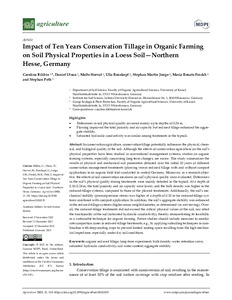| dc.date.accessioned | 2023-01-16T12:49:02Z | |
| dc.date.available | 2023-01-16T12:49:02Z | |
| dc.date.issued | 2023-01-04 | |
| dc.identifier | doi:10.17170/kobra-202301137377 | |
| dc.identifier.uri | http://hdl.handle.net/123456789/14368 | |
| dc.description.sponsorship | Gefördert durch den Publikationsfonds der Universität Kassel | |
| dc.language.iso | eng | |
| dc.rights | Namensnennung 4.0 International | * |
| dc.rights.uri | http://creativecommons.org/licenses/by/4.0/ | * |
| dc.subject | organic reduced tillage | eng |
| dc.subject | long-term experiment | eng |
| dc.subject | bulk density | eng |
| dc.subject | water retention curve | eng |
| dc.subject | saturated hydraulic conductivity | eng |
| dc.subject | soil water content | eng |
| dc.subject | aggregate stability | eng |
| dc.subject.ddc | 630 | |
| dc.title | Impact of Ten Years Conservation Tillage in Organic Farming on Soil Physical Properties in a Loess Soil—Northern Hesse, Germany | eng |
| dc.type | Aufsatz | |
| dcterms.abstract | In conservation agriculture, conservation tillage potentially influences the physical, chemical, and biological quality of the soil. Although the effects of conservation agriculture on the soil’s physical properties have been studied in conventional management systems, studies on organic farming systems, especially concerning long-term changes, are scarce. This study summarizes the results of physical and mechanical soil parameters obtained over the initial 10 years of different conservation management treatments (plowing versus reduced tillage with and without compost application) in an organic field trial conducted in central Germany. Moreover, as a research objective, the effects of soil conservation measures on soil’s physical quality were evaluated. Differences in the soil’s physical quality during treatments were mainly detected in the topsoil. At a depth of 0.10–0.24 m, the total porosity and air capacity were lower, and the bulk density was higher in the reduced-tillage systems, compared to those of the plowed treatments. Additionally, the soil’s mechanical stability (precompression stress) was higher at a depth of 0.10 m for reduced-tillage systems combined with compost application. In addition, the soil’s aggregate stability was enhanced in the reduced-tillage systems (higher mean weight diameter, as determined via wet sieving). Overall, the reduced-tillage treatments did not exceed the critical physical values of the soil, nor affect the functionality of the soil (saturated hydraulic conductivity), thereby demonstrating its feasibility as a sustainable technique for organic farming. Future studies should include measures to ameliorate compaction zones in reduced-tillage treatments, e.g., by applying subsoiling techniques in combination with deep-rooting crops to prevent limited rooting space resulting from the high mechanical impedance, especially under dry soil conditions. | eng |
| dcterms.accessRights | open access | |
| dcterms.creator | Bilibio, Carolina | |
| dcterms.creator | Uteau, Daniel | |
| dcterms.creator | Horvat, Malte | |
| dcterms.creator | Rosskopf, Ulla | |
| dcterms.creator | Junge, Stephan Martin | |
| dcterms.creator | Finckh, Maria Renate | |
| dcterms.creator | Peth, Stephan | |
| dc.relation.doi | doi:10.3390/agriculture13010133 | |
| dc.subject.swd | Nordhessen | ger |
| dc.subject.swd | Biologischer Landbau | ger |
| dc.subject.swd | Bodenbearbeitung | ger |
| dc.subject.swd | Wasserrücklage | ger |
| dc.subject.swd | Schüttdichte | ger |
| dc.type.version | publishedVersion | |
| dcterms.source.identifier | eissn: 2077-0472 | |
| dcterms.source.issue | Issue 1 | |
| dcterms.source.journal | Agriculture | eng |
| dcterms.source.volume | Volume 13 | |
| kup.iskup | false | |
| dcterms.source.articlenumber | 0133 | |


